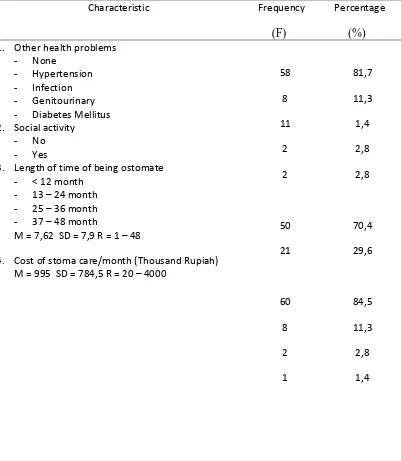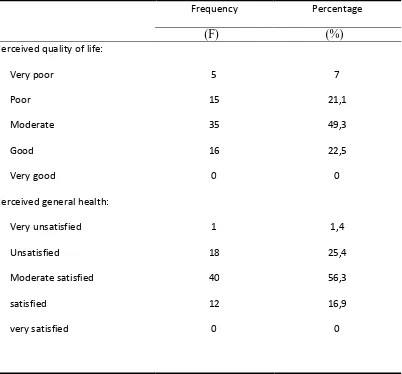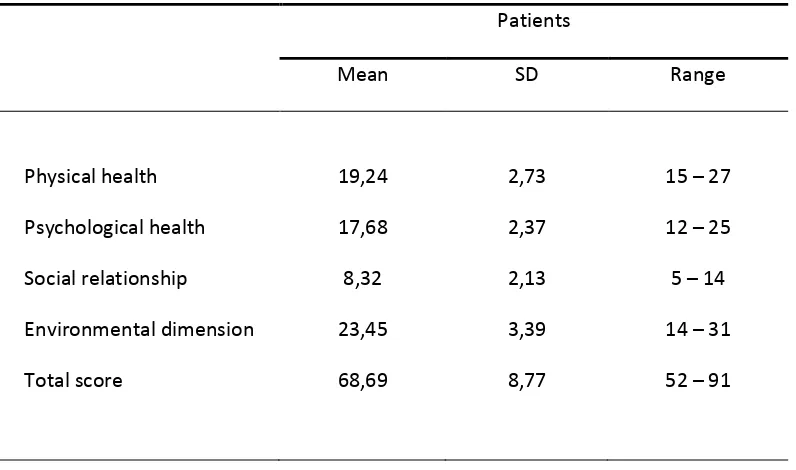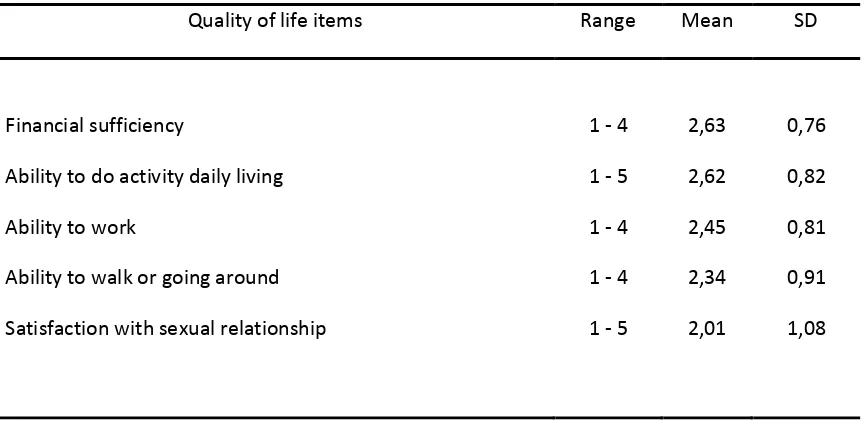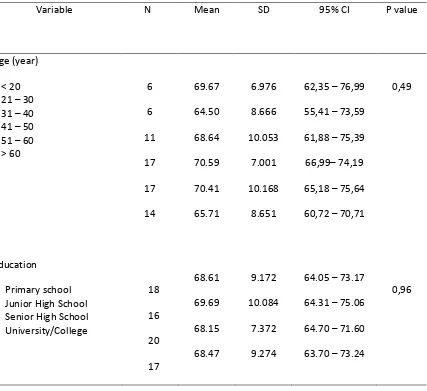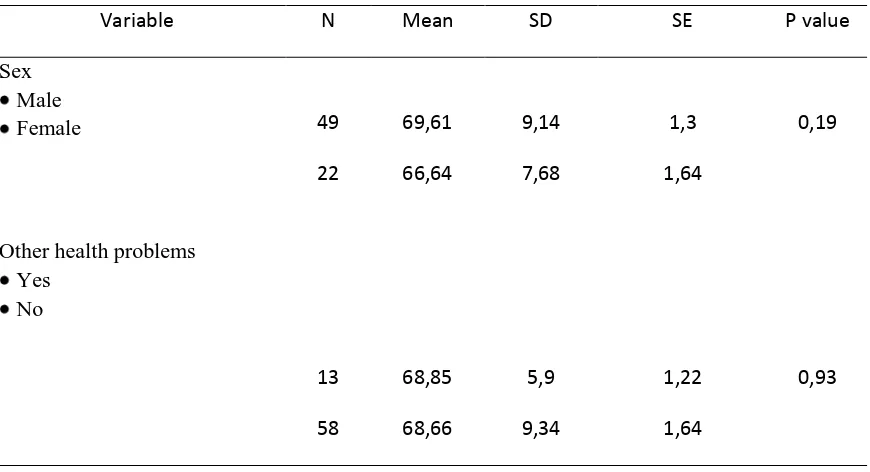QUALITY OF LIFE OF COLOSTOMY PATIENTS IN BANDUNG, INDONESIA*
Kusman Ibrahim
Faculty of Nursing, Padjadjaran University
*Manuscript was Presented in The 2013 International Nursing Conference on Health, Healing, & Harmony: Nursing Values, May1-3, 2013, Phuket, Thailand
ABSTRACT
Colosto i posed a ultiple i pa ts to the patie ts life i ludi g ph si al, ps hologi al, so ial, a d
spiritual. This study aims to identify the level of quality of life as well as to examine the differences of quality of life among colostomy patients with regard to certain demographic characteristics.
Seventy-one colostomy patients were recruited purposively to participate in the study. Data were collected by using the WHO Quality of Life –BREF instrument. One-way ANOVA and Independent t- test were employed to examine the differences of quality of life with regard to certain demographic characteristics.
The study found that the majority of subjects perceived their level of quality of life ranged between e lo to moderate ,4% . “atisfa tio ith suppo t f o f ie ds as ated as the highest ite of quality of life, whereas satisfaction with sexual relationship was rated as the lowest item of quality of life. The e as o sig ifi a t diffe e e of patie ts uality of life with regard to age groups, educational background, length of being ostomate, sex, and other health problems.
The study implied that nurses need to realize and pay much attention to multiple aspects of stoma patie ts ualit of life. A o goi g assess e ts a d e aluatio s of patie ts ualit of life e e e t e el eeded to desig app op iate u si g a e to i p o e patie ts ualit of life. Nu si g a e
should not merely focus on stoma care but also holistically considering on meeting the sexual needs, as well as psychological, social, and spiritual needs of the patients.
INTRODUCTION
Colorectal cancers are remaining as a serious public health problem in Indonesia. The number of people living with colorectal cancer continues to increase by the year to year. Data on 2008 showed that colorectal cancer was listed as the third most prevalent cancer after lung cancer, and prostate cancer on male (Sudoyo, 2012). In Europe and United States, the number of people living with colorectal cancer was more than in Asia. In 2001, there was approximately 135,400 cases reported and 56,700 of them died because of the disease (Williams & Hopper, 2003).
One of the common treatments for the colorectal cancer is surgery by removing the section of affected colon, followed by making a hole (stoma) on the abdominal wall to eliminate the feces. This procedure is known as colostomy. There are two type of colostomy according to the duration of this treatment is required; temporary and permanent. Those who undergoing colostomy permanently mean they have live with colostomy for the rest of their life. Such condition would impact to multi facet of patie ts life i ludi g ph si al, ps hologi al, so ial, a d spi itual ell ei g. I the othe o d, this
may also impact to the life satisfaction, well- being, and quality of life of the patients.
Quality of life has become a major concern among health care professionals since it can be an outcome of health care interventions. Moreover, the quality of life data also can be as data base to determine the appropriate interventions for the patients. Several studies have been done to investigate health-related quality of life among colostomy patients (Barreire, Oliveira, Kazama, Kimura, & Santos, 2003; Cheung, Molassiotis, & Chang, 2003; Karadag, Mentes, Uner, Irkorucu, Ayaz, & Ozkan, 2003; Gooszen, Geelkerken, Hermans, Lagaay, & Gooszen, 2000). However, there is no known study on quality of life of colostomy patients in Indonesia, and more specifically in Bandung, West Java.
METHODS
The study used oss se tio al and des ipti e a al ti al approach. Seventy-one respondents were recruited purposively. The inclusion criteria of recruited respondents were adult, able to write and read in Indonesia, having no serious health problems, and voluntarily willing to participate in the study. Data were collected using the WHO-BREF Quality of Life instrument which already translated into Indonesian language. Then, the data were analyzed for both descriptively and inferentially. O e-way ANOVA and I depe de t t-test were used to test the difference quality of life based on certain characteristics.
RESULTS
Characteristics of the respondents
The demographic and health characteristics of the respondents as presented in the table 1 and table 2.
Characteristics Frequency Percentage
(F) (%)
1. Age (year) - < 20 - 21 - 30 - 31 - 40 - 41 - 50 - 51 - 60 - >60
M = 46,59 SD = 15,,31 R = 17 – 78 2. Sex - Male - Female 3. Religion - Islam - Christian 4. Education
Table 1 continued
Characteristics Frequency Percentage
(F) (%)
5. Occupation - Unemployed - Farmer - Civil servant - Employee - Self-employee - Retirement - Housewives - Labor
6. Monthly Income (Indonesia Rupiah) - No income
- < 500,000
- 500,000 – 1,000,000 - 1,000,001 – 2,000,000 - > 2,000,000
Table 2 Health characteristics of the respondents (N = 71)
Characteristic Frequency Percentage
(F)
(%)
1. Other health problems - None
- Hypertension - Infection - Genitourinary - Diabetes Mellitus 2. Social activity
- No - Yes
3. Length of time of being ostomate - < 12 month
- 13 – 24 month - 25 – 36 month - 37 – 48 month
M = 7,62 SD = 7,9 R = 1 – 48
4. Cost of stoma care/month (Thousand Rupiah) M = 995 SD = 784,5 R = 20 – 4000
Table 2 Continued
Characteristics Frequency Percentage
(F)
(%)
5. Perception toward self health status - Good
- Moderate - Poor
6. Family relationship - Good
- Moderate
16 39 16
69 2
22,5 54,9 22,5
97,2 2,8
Quality of life
Table 3 Perceived quality of life and general health (N = 71)
Frequency Percentage
(F)
(%)
Perceived quality of life: Very poor
Poor Moderate Good Very good
Table 4 Mean score, standard deviation, and rage for each dimension of quality of life
Patients
Mean SD Range
Physical health Psychological health Social relationship Environmental dimension Total score
19,24 17,68 8,32 23,45 68,69
2,73 2,37 2,13 3,39 8,77
15 – 27 12 – 25 5 – 14 14 – 31 52 – 91
Table 5 presents the ranking of five top items of quality of life that selected by the
respondents as the high satisfactory items of their quality of life.
‘
Satisfaction with support from
friends
’
was selected as the highest item of their quality of life, followed by satisfaction with
living place, health assistances, meaning of life, and enjoying life. Oppositely, table 6 presents
the ranking of five low items of quality of life that selected by the respondents as the lower
satisfactory items of their quality of life.
It seems that ‘satisfaction with sexual relationship’ was
selected by most respondents as the lowest satisfactory item of their quality of life, followed by
ability to walk and going around, ability to work, ability to do activity daily living, and ability to
Table 5 Mean score and standard deviation of the five top items quality of life
Quality of life items Range Mean SD
Satisfied with support from friends 1 - 5 3,39 0,75
Satisfied with the living place 1 - 5 3,38 0,66
Satisfied with health assistances 1 - 5 3,25 0,95
Meaning of life 1 - 5 3,15 0,75
Enjoying life 1 - 5 3,13 0,67
Note: the range of each item is from 1 to 5, the higher of mean score for each item indicated the higher level of quality of life
Table 6 Mean score and standard deviation of the five top items quality of life
Quality of life items Range Mean SD
Financial sufficiency 1 - 4 2,63 0,76
Ability to do activity daily living 1 - 5 2,62 0,82
Ability to work 1 - 4 2,45 0,81
Ability to walk or going around 1 - 4 2,34 0,91
Note: the range of each item is from 1 to 5, the lower of mean score for each item indicated the lower level of quality of life
The differences quality of life based on certain demographic characteristics (age, sex, education, length of time undergoing stoma, and health problems)
Results from statistical test by using ANNOVA and independent t-test found that there
were no significant differences of total quality of life score with regard to age group, education,
occupation, length of time of being ostomate, sex, and other health problems, as presented in the
table 7 and table 8 below.
Table 7 The differences of total mean score of quality of life based on age group, education,
occupation, and length of time of being ostomate
Variable N Mean SD 95% CI P value
Age (year) - < 20 - 21 – 30 - 31 – 40 - 41 – 50 - 51 – 60 - > 60
6 6 11 17 17 14 69.67 64.50 68.64 70.59 70.41 65.71 6.976 8.666 10.053 7.001 10.168 8.651
62,35 – 76,99 55,41 – 73,59 61,88 – 75,39 66,99– 74,19 65,18 – 75,64 60,72 – 70,71
0,49
Education
- Primary school - Junior High School - Senior High School - University/College 18 16 20 17 68.61 69.69 68.15 68.47 9.172 10.084 7.372 9.274
64.05 – 73.17 64.31 – 75.06 64.70 – 71.60 63.70 – 73.24
Table 7 Continued
Variable N Mean SD 95% CI P value
Occupation - Unemployed - Farmer - Civil servant - Employee - Self-employee - Retirement - Housewives - Labor
Length of time of being ostomate
- < 12 month - 13 – 24 month - 25 – 36 month - 37 – 48 month
15 7 6 7 11 12 11 2 60 8 2 1 66.80 75.00 73.50 67.29 70.09 65.83 65.45 78.50 69.13 66.75 63.00 69.00 8.521 4.243 11.675 8.381 8.893 6.780 7.992 17.678 - 1.155 3.075 4.000
62.08 – 71.52 71.08 – 78.92 61.25 – 85.75 59.53 – 75.04 64.12 – 76.07 61.53 – 70.14 60.09 – 70.82 -80.33 –237.33
- 66.82 – 71.44 59.48 – 74.02 12.18 – 113.82
Table 8 The differences of total mean score of quality of life based on sex and other health problems
Variable N Mean SD SE P value
Sex Male Female 49 22 69,61 66,64 9,14 7,68 1,3 1,64 0,19
Other health problems Yes No 13 58 68,85 68,66 5,9 9,34 1,22 1,64 0,93 DISCUSSION
Results of the study show that majority of the respondents (77.4%) perceived their level quality of life a ged f o e poo to ode ate . No e of the pe ei ed thei le el of ualit of life at e good . It is u de sta da le si e the p ese t of stoma on the part their body may interference their daily activities as well as their body image which influence the interaction with others. Thus, presentation of stoma would influence their perception toward themselves which determined the life satisfaction. Karadag, et al (2002) pointed out that colostomy application might have negative impact o the patie ts ualit of life. Zhan (1992) argued that meaning of quality of life was constructed from a transactional process between an individual with environment that was influenced by personal background, health, social situation, culture,and level of age.
health. General health condition of colostomy patients were usually good as long as there were no associated complications which might impact their general health.
“atisfa tio ith suppo t f o f ie ds as selected by the respondents as the most satisfactory item of quality of life (M=3.39 SD=0.75), followed by satisfaction with living place, health assistances, meaning of life, and enjoying life. This result reflected the culture of collectivity that commonly embedded in the Eastern Society, including Sundanese which constituted to majority of the respondents. The Sundanese philosophy of saling asah, saling asih, dan saling asuh (reciprocity in caring and empowerment) has been underlying moral values to provide care, assistances, help, and support among family members, relatives, neighbors, and community at larger scope. It was common phenomenon in Sundanese society that when a community members being sick, he/she would receive a lot attention from the relatives, neighbors, and community surrounded which emphasize on providing support, comfort, and prayers for the sick. It is supported by the data that almost all respondents (97.2%) a k o ledged the suppo t f o thei fa il . “atisfa tio ith li i g pla e i di ated that ost respondents felt comfort with their home condition. It can be a base data to develop home-based care for colostomy patients. In term of health assistances received, most respondents felt satisfy with the health service given by the health care provider. Although the respondents have to undergo stoma on their abdomen, they are still able to enjoy their life and experience the meaning of their life..
Satisfaction with sexual relationship was chosen as the lowest item quality of life by the most respondents. This possibly because lack of knowledge about various position that could be considered in sexual relationship between respondents and their spouses. This condition resulted low self-confidence of the respondents to perform sexual acti ities. The ajo it of espo de ts age a ged f o to years old, and married. In the range of age, they were considered as sexually active, particularly males. The presentation of stoma hole on the abdomen was often resulting negative self-perception toward body image, and less sexually attractive to the spouses. As consequence, the sexual desire might decrease. Nurses needed to be concern about this issue and discuss with patients and their spouses to find solutions. In the Eastern culture, it was commonly believed that sexuality viewed as a personal matter and taboo to tell others. Building trust relationship between nurses and patients with empathy a d a i g ould e a ke of patie ts su ess to ha o ize thei se ual elatio ships.
the old stoma bag. The data implied nurses need to assess the patients e o o i a ilit to sele t hi h materials appropriate and affordable for the patients.
The results of bivariate analysis revealed that there were no significant differences between
quality of life score with regards to age groups, education background, occupation, length of
being ostomate, sex, and other health problems experienced. This possibly due to the
respondents’ variation regarding their characteristics was not much different, which led them to
select the same items of quality of life. There was difficulty to draw a heterogeneous subject in
this study.
CONCLUSION AND RECOMENDATIONS
Quality of life become a major issue among patients post colostomy surgery. The study
found m
ajority of patients perceived their level of quality of life ranging from “very poor” to
“moderate”, and
their current health status were ranged from
“very unsatisfied” to “moderate
satisfaction”
. There were no significant differences of total quality of life score with regard to
age group, education, occupation, length of time of being ostomate, sex, and other health
problems. This study highlighted the common phenomenon of impact colostomy on the quality
of life and several characteristics factors that may influence to quality of life. It implied that
nurses need to take into consideration to evaluate the quality of life of colostomy patients
REFERENCES
Anderson, K.L., & Burckhardt, C.S. (1999). Conceptualization and measurement of quality of
life as an outcome variable for health care intervention and research.
Journal of AdvancedNursing,
29, 298-306.
Corless, I.B., Nicholas, P.K, & Nokes, K.M. (2001). Issues in cross cultural quality of life
research.
Journal of Nursing Scholarship,33, 15-20
Farquhar, M. (1995). Definitions of quality of life: a taxonomy. Journal of Advanced Nursing, 22, 502-508
Gooszen, AW, Geelkerken, RH, Hermans, J, Lagsay, MB, Gooszen, HG.(2000). Quality of life
with a temporary stoma: ileostomy vs. colostomy.
Diseses Colon Rectum, 43(5): 650-655Haberman, M.R., & Bush, N. (1998). Quality of life methodological and measurement issues. In
C.R. King & P.S. Hinds (Eds.),
Quality of life, from nursing and patient perspectives(pp.117-139). Canada: Jones and Bartlett Publishers
Ignatavicius, D.D., (1995).
Medical surgical nursing, a nursing process approach. Philadelphia:
WB Saunders Company.
Inaba, K. (1996). Psychosocial aspects of chronic illness. In P.D. Barry (Ed.),
Psychosocialnursing care of physically ill patients & their families
(pp. 359-374). Philadelphia:
Lippincott
Karadag, A, Mentes, B.B, Uner, A, Irkorucu, O, Ayaz, S, Ozkan, S. (2002). Impact of
stomatheraphy on quality of life in patients with permanent colostomies or ileostomies.
Journal of Colorectal Diseases, 18(3); 234-238
Kurang olah raga pencetus kanker usus
(2000) diambil 19 April 2005 dari
http:www.indomedia.com/intisari/2000/des/terapi-12.htm
Nelson, C.B., & Lotfy, M. (1999).
The World Health Organization’s WHOQoL
-BREF quality of life assessment: psychometric properties and results of the international field trial. WHO(MNH/MHP/99.7).
Retrieved
November
28
th,
2002,
from
http://www.who.int/msa/qol/documents/WHOQOL_BREF.pdf
Polit, D.F., & Hungler, B.P. (1999
). Nursing research, principal and methods.Philadelphia:
Lippincott
The WHOQoL Project.
Retrieved November 28
th, 2003 from
http://www.acpmh.
unimelb
.edu.au/whoqol/ chapter2.htm#after footnote 2
Williams, L.S., & Hopper, P.D. (2003).
Understanding medical-surgical nursing, second edition.
Philadelphia: F.A. Davis Company
WHOQoL Group (1994).
WHOQoL-BREF, introduction, administration, scoring, and genericversion of the assessment, field trial version
. Retrieved November 28
th, 2002, from
http://www.popcouncil.org/horizons/AIDSQuest/Instrument/
WHOQOL-BREF.pdf
Zhan, L. (1992). Quality of life: conceptual and measurement issues
. Journal of Advanced
